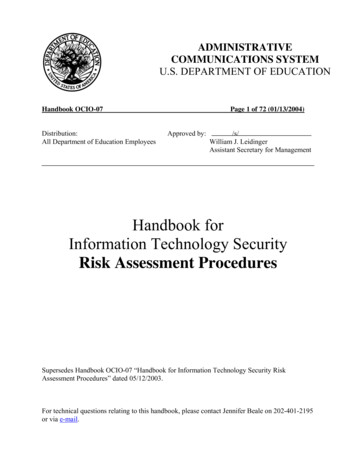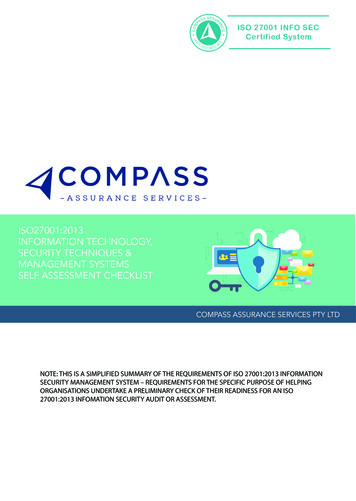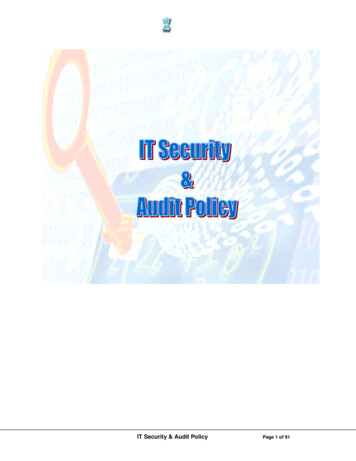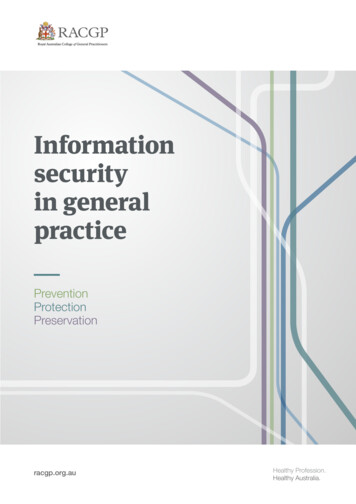
Transcription
ADMINISTRATIVECOMMUNICATIONS SYSTEMU.S. DEPARTMENT OF EDUCATIONHandbook OCIO-07Distribution:All Department of Education EmployeesPage 1 of 72 (01/13/2004)Approved by:/s/William J. LeidingerAssistant Secretary for ManagementHandbook forInformation Technology SecurityRisk Assessment ProceduresSupersedes Handbook OCIO-07 “Handbook for Information Technology Security RiskAssessment Procedures” dated 05/12/2003.For technical questions relating to this handbook, please contact Jennifer Beale on 202-401-2195or via e-mail.
DEPARTMENT OF EDUCATIONINFORMATION TECHNOLOGY SECURITYInformation Technology SecurityRisk Assessment ProceduresDecember 2003
Handbook for Information Technology Security Risk Assessment Procedures01/13/2004TABLE OF kground .1Scope.1Structure.2RISK ASSESSMENT CONCEPTS.32.1 Why Conduct a Risk Assessment? .32.2 When Should a Risk Assessment be Conducted?.32.3 How is the Required Level of Effort for a Risk Assessment Determined? .42.3.1 What if the GSS or Application is Categorized as a Tier 0? .42.4 How does the Risk Assessment Feed into the C&A Process?.52.5 Who is Responsible for Conducting the Risk Assessment? .62.6 What is Information Sensitivity and Mission Criticality? .72.6.1 Information Sensitivity.82.6.2 Mission Criticality .92.7 How are Threat and Vulnerability Defined?.92.7.1 Threat.92.7.2 Vulnerability .112.7.3 Relationship Between Threat and Vulnerability.112.8 Which Security Domains Should be Assessed? .112.9 What Information Gathering Techniques Should be Used When Conducting a RiskAssessment?.122.9.1 Questionnaire.122.9.2 Interviews.122.9.3 Documentation Review .132.9.4 Scanning Tools.133.CONDUCTING A RISK ASSESSMENT.153.13.23.33.43.53.64.Step 1:Step 2:Step 3:Step 4:Step 5:Step 6:Characterize the System .16Identify Threats.17Identify Vulnerabilities.17Analyze Risk.18Identify Recommendations.20Document Results.21SUMMARY .22APPENDIX A. GLOSSARY OF TERMS .1APPENDIX B. ACRONYMS.1APPENDIX C. REFERENCES .1ii
Handbook for Information Technology Security Risk Assessment Procedures01/13/2004APPENDIX D. BASELINE SECURITY REQUIREMENTS (BLSRS) .15.MANAGEMENT CONTROLS.15.1.15.1.25.1.35.1.45.1.56.OPERATIONAL CONTROLS .106.1.117.Authorize Processing .1Life Cycle .1Risk Management.3Rules of Behavior.4System Security Plan.5Configuration Management .6Contingency Planning.7Documentation.10Environmental Security.11Incident Handling .12Information Sharing.13Personnel Security .14Physical Security.16Production Input/Output Controls.18Public Access Controls .19Security Awareness and Training .20TECHNICAL CONTROLS.217.1.17.1.2Auditing.21Identification and Authentication .22APPENDIX E. VULNERABILITY QUESTIONNAIRE.1APPENDIX F. SYSTEM DISPOSAL CHECKLIST .1APPENDIX G. RISK ASSESSMENT REPORT FORMAT .1APPENDIX H. RISK ASSESSMENT SECURITY ACTION PLAN LETTERTEMPLATES.1iii
Handbook for Information Technology Security Risk Assessment Procedures01/13/20041. INTRODUCTION1.1PurposeThe Risk Assessment Procedures are intended to provide information to the Department ofEducation (Department) information technology (IT) security professionals (e.g., computersecurity officers [CSO], system security officers [SSO], network security officers [NSO])responsible for the security of the Department’s general support systems (GSS) and majorapplications (MA) and the risk analysis of those GSSs and MAs. These procedures are writtenwith the assumption that the reader has some basic knowledge of IT security and the associateddisciplines as described by the National Institute of Standards and Technology (NIST). Theprocedures outline a systematic, flexible, step-by-step approach that can be implementedconsistently across the Department. It establishes the parameters and minimum standardsrequired for a Department risk assessment as in accordance with Office of Management andBudget (OMB) Circular A-130, and NIST Special Publication (SP) 800-30. These proceduresmay be used by a system owner to: 1) perform risk assessments during all stages of the system'slife cycle; 2) provide guidance to contractors responsible for developing a system in preparationfor an independent risk assessment; and/or 3) understand the risk assessment reports performedby the independent risk assessor.1.2BackgroundRisk is a measure of the degree to which information resources are exposed based on theexploitation of a vulnerability by a potential threat 1 . Risk is composed of two elements: 1) theimpact that an exploited vulnerability would have on the organization’s mission or operations;and 2) the likelihood that such an exploitation would occur. A risk assessment is the process ofanalyzing and then interpreting risk associated with potential threats and vulnerabilities. Therisk assessment acts as a means to help evaluate the effectiveness of various security controls inplace for each GSS or MA 2 .The Department of Education Information Technology Security Risk Assessment Procedures iswritten to support the Department’s risk management based Department of EducationInformation Technology Security Policy, which states that risk assessments must be performed atleast every three years or whenever a significant change occurs to the GSS or MA.1.3ScopeThe scope of these procedures includes what a risk assessment is, why a risk assessment isimportant, how a risk assessment feeds into the certification and accreditation (C&A) process,and the minimal security requirements for conducting a risk assessment. These procedures arebased upon the Department of Education Information Technology Security Policy, Departmentof Education Information Technology Security Program Management Plan, NIST SP 800-30,OMB Circular A-130, and other applicable Federal IT security laws and regulations. The1 Vulnerability and threat are addressed in Section 2.2 According to NIST SP 800-18, Procedures for Developing Security Plans for Information Technology Systems, securitycontrols are categorized into three domains: management, operational, and technical. These domains are discussed in furtherdetail in Section 2.8.1
Handbook for Information Technology Security Risk Assessment Procedures01/13/2004process documented in these procedures will be used in performing risk assessments for all GSSsand MAs throughout the Department 3 .1.4StructureThese procedures are organized into three major sections. Section 1 introduces the risk assessment process.Section 2 provides an overview of the major risk assessment concepts as well as howthe risk assessment is related to the C&A process.Section 3 describes how to conduct a complete and thorough risk assessment(characterize the system, identify threats, identify vulnerabilities, analyze risk,recommend remediation measures, and document results).Supporting the procedures are nine appendices; these appendices provide useful references (e.g.,glossary of terms, acronyms, references, baseline security requirements (BLSRs), points ofcontact, vulnerability questionnaire, system disposal checklist, risk assessment report format, andrisk assessment security action plan letter templates).3 The Department of Education Information Technology Security General Support Systems and Major Applications InventoryProcedures can be used to help determine if a particular system is a GSS or MA.2
Handbook for Information Technology Security Risk Assessment Procedures01/13/20042. RISK ASSESSMENT CONCEPTS2.1Why Conduct a Risk Assessment?The Department of Education Information Technology Security Policy requires risk assessmentsbe performed on all GSSs and MAs. The purpose of the risk assessment is to quantify the impactof potential threats on a particular vulnerability to a GSS or MA. The benefits of performing arisk assessment include 2.2Identifying GSS or MA weaknessesEnabling management to make informed decisions regarding implementation ofsecurity controls and remediation measuresPromoting a consistent approach to measuring riskAllowing stakeholders to place values on potential lossesPrioritizing levels of risk based on mission criticality and information sensitivity.When Should a Risk Assessment be Conducted?According to Federal regulations, Principal Officers are required to conduct a risk assessment ofall GSSs or MAs at least every 3 years or when there is a major change in the GSS or MAenvironment, whichever occurs first. Ideally, some form of risk assessment must be performedduring each phase of the system development lifecycle (SDLC) 4 . The phase of the SDLC duringwhich the risk assessment is performed determines the level of detail, availability, andsometimes the sources of data. For example, the Baseline Security Requirements, in AppendixD, must be used as a checklist when performing a risk assessment for a GSS or MA in Phase 1 ofthe SDLC. Note that the System Disposal Checklist, in Appendix F must be utilized to ensurenecessary steps have been taken to dispose of the GSS or MA. Table 1 describes theDepartment’s SDLC phases and related risk assessment activities.Table 1. SDLC Phases and Related Risk Assessment ActivitiesSDLC PhasePhase 1 – Project InitiationPhase 2 – RequirementsSpecificationPhase 3 – DesignRisk Assessment ActivityRisks are identified to ensure security controls are being considered andwill be built into the GSS or MA. Conduct a high-level risk assessmentusing the BLSRs in Appendix D as a checklist to ensure security controlsare being considered and will be built into the GSS or MA.The risks identified during this phase are used to support the developmentof the systems requirements, including security requirements.The risks identified during this phase can be used to support the securityanalyses of the GSS or MA that may lead to architecture and design tradeoffs during the design phase. A GSS or MA Inventory submission formmust be submitted to the Office of the Chief Information Officer (OCIO)during this phase. This will assess the anticipated mission criticality andinformation sensitivity of the system.4 It is best to perform a risk assessment early in the cycle to avoid security retrofits. These retrofits are often costly and requiresignificant levels of effort.3
Handbook for Information Technology Security Risk Assessment ProceduresSDLC PhasePhase 4 – BuildPhase 5 – TestPhase 6 – DeployPhase 7 – MaintainPhase 8 – Disposal2.301/13/2004Risk Assessment ActivityExamination of the requirements specification phase is performed toensure that the business case, project plan, and risk management plan arefollowed.Decisions regarding risks identified must be made prior to deployment.During this phase, and before the next phase of deployment, anindependent risk assessment that meets the minimum standards of thisprocedures must be performed.The risk management process supports the assessment of the GSS or MAimplementation against its requirements and within its modeledoperational environment. Decisions regarding risks identified must bemade prior to system maintenance.It is good practice to perform a risk assessment during the maintenance ofthe GSS or MA—in anticipation of the occurrence of an event or evenafter the occurrence of an event—to analyze vulnerabilities andrecommend remediation measures.Risk management activities are performed for GSS or MA componentsthat will be disposed of or replaced to ensure that the hardware andsoftware are properly disposed of, that residual data is appropriatelyhandled, and that migration is conducted in a secure and systematicmanner.How is the Required Level of Effort for a Risk Assessment Determined?Department automated information resources 5 (GSSs and applications) are categorized into oneof five certification tiers (e.g., Tier 0 through Tier 4) as listed in Table 2. The certification tier ofthe GSS or MA determines the level of effort required for conducting risk assessments. Missioncriticality and information sensitivity are two attributes used to determine the certification tier 6 .Note: A GSS or MA that is determined to be a Mission-Essential Infrastructure (MEI) Assetthrough the Critical Infrastructure Protection Survey is automatically considered a Tier 4 system.For example, a risk assessment for a Tier 4 GSS or MA will consist of a fully documented,formal analysis, using the BLSRs and any additional system specific security requirements. Inaddition, vulnerability scanning is required as part of the risk assessment for a Tier 4 GSS orMA. However, a risk assessment for a Tier 1 system will consist of using the BLSRs as achecklist and a less detailed, documented analysis.2.3.1 What if the GSS or Application is Categorized as a Tier 0?Applications that are categorized as a Tier 0 are not considered MAs and therefore, do notrequire risk assessments. However, all GSSs are required to undergo a risk assessment, thosethat are categorized as a Tier 0 will utilize the level of effort associated with a Tier 1 GSS.Table 2. Required Level of Effort for Risk Assessment5 Includes both government information and information technology resources.6 Refer to the Department of Education Information Technology Security Certification and Accreditation Procedures for furtherdetails on how the certification tier is determined for the GSS or MA.4
Handbook for Information Technology Security Risk Assessment ProceduresCertificationTier0No risk assessment requiredRisk assessment (using BLSRs as a checklist)2Risk assessment (using BLSRs additional system specific securityrequirements)Risk assessment (using BLSRs additional system specific securityrequirements vulnerability scanning recommended)Risk assessment (using BLSRs additional system specific securityrequirements vulnerability scanning)42.4Required Level of Effort for Risk Assessment1301/13/2004How does the Risk Assessment Feed into the C&A Process?The C&A process is comprised of the following four phases: Phase 1: DefinitionPhase 2: VerificationPhase 3: ValidationPhase 4: Post AccreditationRisk assessments are performed as part of Phase 1 7 . The risk assessment is the foundation fordeveloping all other security documents needed for certifying and accrediting the GSS and MA.The System Security Plan (SSP) must adequately address risks identified in the GSS or MA riskassessment report. The Configuration Management Plan (CMP) and the Contingency Plan (CP)further mitigate risks determined during the assessment. The Security Testing and Evaluation(ST&E) procedures will verify that critical risks highlighted in the risk assessment report havebeen corrected.The result of the risk assessment yields an overall level of risk for the system. When using aqualitative methodology, risk values are rated as high, medium, or low. These results and othercertification documentation are included as part of the C&A documentation provided to theCertifier 8 . Table 3 provides descriptions for each of these values. The risk level descriptionsmust be used consistently throughout the Department, resulting in a standardized approach toidentifying risk levels.Table 3. Risk LevelsRisk LevelHighDescriptionIt is likely that exploitation of a given vulnerability by a threat will severely andadversely impact the Department, resulting in over one million dollars worth ofdamage and/or leading to legal ramifications (e.g., potential jail sentence). Thisrating indicates a strong need for corrective measures and actions.7 Refer to the Department of Education Information Technology Security Certification and Accreditation Procedures for furtherinformation on the C&A process.8 “Certification includes a comprehensive evaluation of the technical and non-technical security features and other IT systemsafeguards. Certification is performed in support of the accreditation process to establish the extent to which design andimplementation of a particular system meet a set of specified security requirements.” – Department of Education InformationTechnology Security Policy.5
Handbook for Information Technology Security Risk Assessment ProceduresMediumLow2.501/13/2004It is likely that an exploitation of a given vulnerability by a threat willmoderately impact the Department, resulting in between 100,000 and onemillion dollars worth of damage or leading to legal action without the potentialof a jail sentence. This rating indicates a strong need for corrective measuresand actions.The given vulnerability may be subject to exploitation by a threat, but theprobability of such exploitation is small and/or its impact on the Department’sassets and resources would be minor, resulting in less than 100,000 dollarsworth of damage or leading to administrative penalties. This rating indicates aneed for corrective measures and actions.Who is Responsible for Conducting the Risk Assessment?The Principal Officer is responsible for ensuring that a risk assessment is conducted, for all GSSsand MAs for which he or she is responsible, in accordance with OMB Circular A-130. The riskassessment team must consist of individuals who are experienced in performing risk assessments(e.g., understand and have applied proven risk assessment methodologies). The team must haveknowledge of Federal laws and regulations associated with risk assessments and have adequatetechnical knowledge of systems and networks. Risk assessment team members must beindependent thus not having a vested interest in the GSS or MA being assessed. Thus, noindividual from the Principal Office (PO) or any individual who supports or maintains thesystem should perform the risk assessment. The independent risk assessment team must workwith the GSS or MA owners and those who administer and support the GSS or MA in order toobtain all the information needed for the assessment.The primary requirement for the risk assessment team is that at least one member be consideredan information security professional. This individual must have a working knowledge ofinformation security controls and must ensure that all information and documentation gatheredfor the risk assessment is treated appropriately as Department sensitive information.All of the roles and responsibilities for the risk assessment process are listed in the table ssuranceOfficePrincipalOfficerResponsibilitiesThe Chief Information Officer (CIO) endorses the remediation plansubmitted by the Principal Officer following a completed riskassessment.The Information Assurance (IA) office within the Office of the ChiefInformation Officer is responsible for developing Department ofEducation information technology security risk assessment policy,procedures and guidance. IA is also responsible for incorporatingand monitoring completion of remediation actions into theDepartment of Education’s FISMA action plan that is reported toOMB.The Principal Officer is responsible for ensuring that a riskassessment is conducted, for all GSSs and MAs for which he or she isresponsible, in accordance with OMB Circular A-130. The PrincipalOfficer participates in interviews with the Risk Assessment Team andsubmits the resulting risk assessment remediation plan to OCIO.6
Handbook for Information Technology Security Risk Assessment TeamResponsibilitiesThe independent risk assessment team completes the risk analysis ofthe system and documents the results in the final Risk AssessmentReport. This team must work with the GSS or MA owners and thosewho administer and support the GSS or MA in order to obtain all theinformation needed for the assessment.The SM represents the interests of the GSS or MA throughout theSystemSDLC. The SM is responsible for ensuring the GSS or MA isManager9operating in accordance with the security controls outlined in the(SM)SSP. The SM participates in interviews with and demonstrations ofthe system for the Risk Assessment Team. The SM signs off on theresulting risk assessment remediation plan that is submitted to OCIO.The CSO manages the efforts of the C&A activities, including theComputerSecurityrisk assessment, and acts as the managing official for informationOfficer (CSO)security of GSSs or MAs within the PO. The CSO participates ininterviews with and demonstrations of the system for the RiskAssessment Team. The CSO signs off on the resulting riskassessment remediation plan that is submitted to OCIO.System Security The SSO is directly responsible for the information security of a GSSOfficer (SSO)or MA within the PO. The SSO ensures that security is considered atevery point in the life-cycle process and manages the integrity of theGSS or MA. The SSO participates in interviews with anddemonstrations of the system for the Risk Assessment Team. TheSSO prepares the resulting risk assessment remediation plan that issubmitted to OCIO.The user representative is responsible for ensuring that the user isUserRepresentative able to conduct normal business activities with the particular GSS orMA. The user representative is the spokesperson for the usercommunity representing the operational interests of the user. Thisrepresentative ensures that user requirements are met during theSDLC allowing the user to perform the tasks defined in their jobdescription. The user representative participates in interviews withand demonstrations of the system for the Risk Assessment Team.2.6What is Information Sensitivity and Mission Criticality?Two very important elements must be considered when performing a risk assessment.Information sensitivity and mission criticality are key components that will be used to assess risklevels. This section addresses when and how information sensitivity and mission criticality arefactored into the risk assessment. The intent of the following two sections is to simply definethese two terms. A more thorough discussion of information sensitivity and mission criticalitycan be found in the Department of Education Information Technology Security General SupportSystems and Major Applications Inventory Procedures.9 The System Manager is also known as the Program Manager.7
Handbook for Information Technology Security Risk Assessment Procedures2.6.1 Information SensitivityThe criteria used to measure the informationsensitivity include: information confidentiality,integrity, and availability. Figure 1 provides adescription of each criteria element.01/13/2004Confidentiality: Protection from unauthorizeddisclosure.Integrity: Protection from unauthorized,unanticipated, or unintentional modification.Availability: Available on a timely basis tomeet mission requirements or to avoidsubstantial losses.Information that is labeled “For Official UseOnly” is confidential and must be protected from-Source: Department of Education nology Security General Support Systems and MajorApplications Inventory Proceduresdisclosure of this information may result in atangible and intangible loss to the agency.Figure 1. Information Sensitivity CriteriaConfidential information (i.e., informationlabeled as “For Official Use Only) is sensitiveand may contain any of the following types of data Proprietary business information that may not be released to the public under theFreedom of Information Act or other lawsPersonal data that requires protection under the Privacy Act of 1974.Source Selection information for contractsDeliberative process materialsMonetary or budgetary information that would permit circumvention of securitymeasures and internal controlsRefer to the Department of Education Information Technology Security General SupportSystems and Major Applications Inventory Procedures for additional guidance on assigninglevels of high, medium, or low for each information sensitivity criteria. This guidance will assistin determining an overall information sensitivity level for the GSS or MA and the data housed onthat GSS or MA.When considering the type of data transmitted, stored, or processed (e.g., privacy data) on theGSS or MA, it is important to note that sensitive information includes, but is not limited to Social security numbersPersonal addressesCredit history8
Handbook for Information Technology Security Risk Assessment Procedures2.6.2 Mission CriticalityIn accordance with the Department ofEducation Information Technology SecurityGeneral Support Systems and MajorApplications Inventory Procedures, thecriterion used to measure mission criticality isclosely related to how integral the system is tosupporting the mission of the Department.01/13/2004Mission Critical: Automated informatio
Education (Department) information technology (IT) security professionals (e.g., computer security officers [CSO], system security officers [SSO], network security officers [NSO]) responsible for the security of the Department's general support systems (GSS) and major applications (MA) and the risk analysis of those GSSs and MAs.










